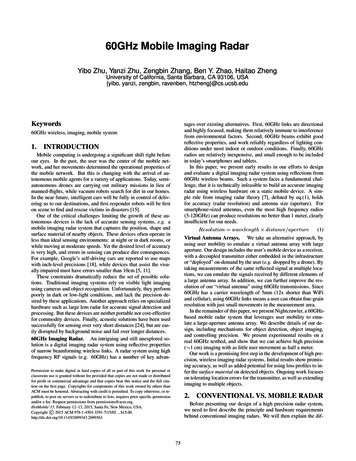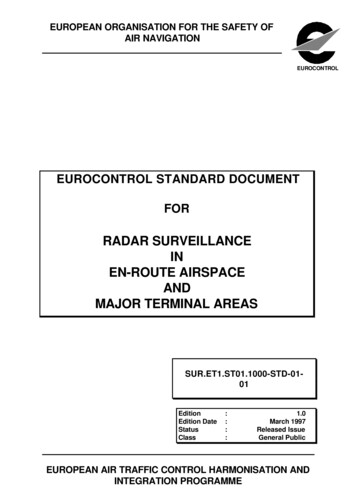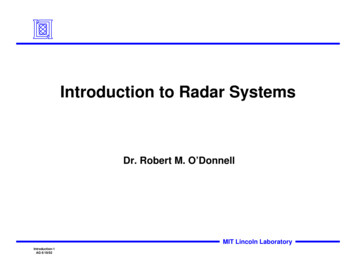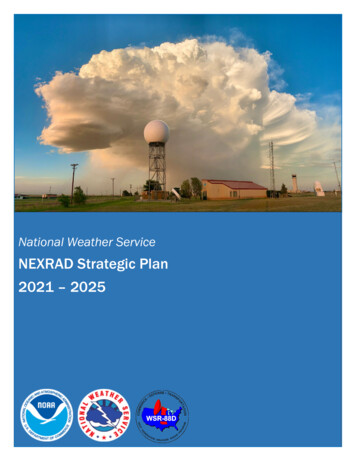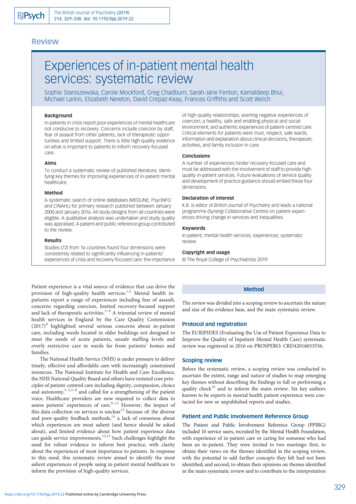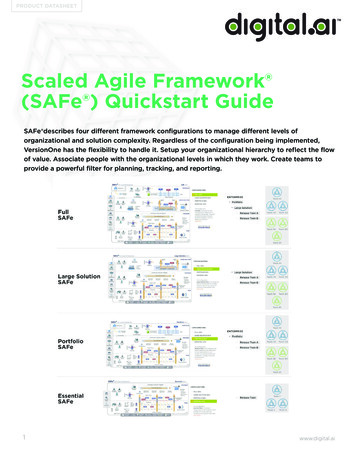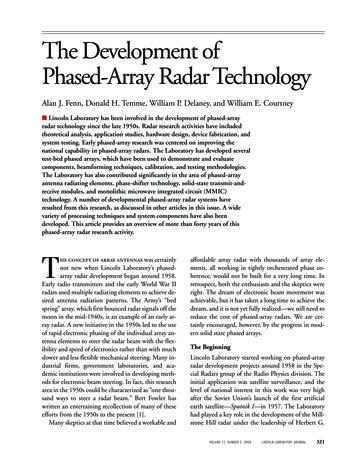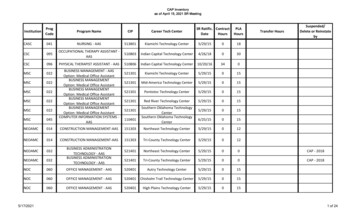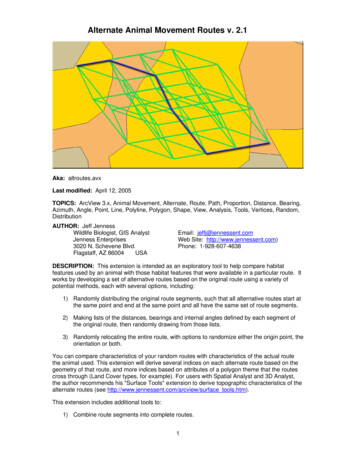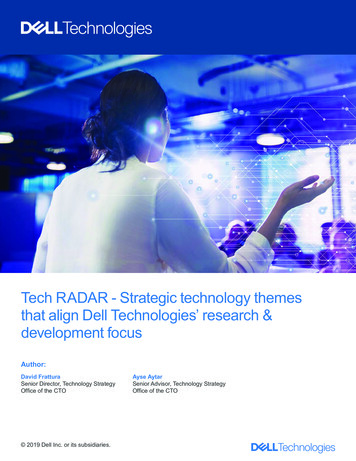
Transcription
Tech RADAR - Strategic technology themesthat align Dell Technologies’ research &development focusAuthor:David FratturaSenior Director, Technology StrategyOffice of the CTO 2019 Dell Inc. or its subsidiaries.Ayse AytarSenior Advisor, Technology StrategyOffice of the CTO
Table of contentsIntroduction. 3Enterprise IT technology requirements are changing, driven by Digital TransformationTech RADAR - Technology themes that will define investments over the next three years. 4Figure: Top strategic technology themes through 2022System optimizing technologies: Building blocks enabling next generation workloads. 5Figure 1: System optimizing technology inventoryNext generation communications: Extending IT beyond the data center to the Edge and multi-cloud. 6Figure 2: Next generation communications technology inventoryCloud stack evolution: Transition to a multi-cloud landscape and cloud native architectures. 7Figure 3: Cloud stack evolution technology inventoryEdge and decentralized IT: Disaggregating enterprise systems. 8Figure 4: Edge and decentralized IT technology inventoryIntelligent automation & orchestration: Heading towards self-driving infrastructure. 9Figure 5: Intelligent automation & orchestration technology inventoryData management: Unlocking the latent value of data. 10Figure 6: Data management technology inventoryIntrinsic trust & security: Transition from border security to an integrated model. 11Figure 7: Intrinsic trust & security technology inventoryData science (AI & Analytics): Accelerating time to actionable insight in the digital enterprise. 12Figure 8: Data science technology inventoryCitizen developers & DevOps: New toolchains and frameworks to democratize application development. 13Figure 9: Citizen developers & DevOps technology inventoryBlockchain and immutable ledgers: Enabling smart contracts, data provenance and decentralized identities. 14Figure 10: Blockchain and immutable ledgers technology inventoryNatural user interfaces: Transforming enterprise interactions. 15Figure 11: Natural user interfaces technology inventoryAugmented and Virtual Reality: Immersive interfaces to take off to effectively sift and visualize massive amounts of data. 16Figure 12: Augmented and Virtual Reality technology inventoryIn Summary. 172 2019 Dell Inc. or its subsidiaries.
IntroductionAs digital transformation becomesmore entwined with businessmodels across industries, ITleaders are expected to advocatefor and support strategicchange. To help our customersachieve and sustain competitiveadvantage in a data-drivenworld, Dell Technologies’ Officeof the Chief Technology Officerhas developed a frameworkand methodology to surface keyemerging trends and technologieswhich then are used to alignDell Technologies’ researchand development efforts. Thisframework is called the TechRADAR by Dell Technologies, andthis white paper provides a view ofthe themes that are drivingDell Technologies’ investments.12Enterprise IT technology requirements are changing,driven by Digital TransformationEnterprises are continuing to embrace digital transformation initiatives worldwide andby IDC’s estimates, will invest a total of 7.4T1 in related technology and services fromnow until 2023. In the digital enterprise, data is central to running the business. Datawill increasingly be used for interacting with and understanding customers, as well asfor enhancing internal IT operations and managing security. Moreover, data will bedistributed and will grow exponentially, from 16.3 zettabytes (ZB) of data in 2017 to175 ZB2 of data in 2025. Data, and the analysis of it, will drive the pace of innovationin IT Technology.Enterprises are also decentralizing their IT systems, establishing IT footprints in publicclouds, co-locations and privately-owned data centers and at the edge of their networksin order to host workloads in the most appropriate location for their application. Themulti-cloud reality is already here, but it will become even more entrenched in the futurewith the proliferation of edge use cases. Over the next decade, enterprises will needto invest in technologies, immersive interfaces and skillsets that enable them toconsume and exploit the data at their fingertips for competitive differentiation andproductivity advancements.Developers and data scientists are creating new value and transforming enterprises intodigital businesses. With the increasing impact these individuals have on their enterprises’future, they will have even greater influence on how IT selects and deploys infrastructurein support of their needs.With cloud-based models becoming a central foundation for IT strategies, the demandfor ‘as-a-service’ consumption is also becoming key to how enterprises expect to procuretechnology. The cloud services operational model allows enterprises to use only theresources they need and in turn lower direct expenditures for assets with low or sporadicutilization. Services-centric operations and consumption-based economics will permeateacross all IT technology markets.IDC Worldwide Semiannual Digital Transformation Spending Guide, 2018H2IDC White Paper, sponsored by Seagate, Data Age 2025: The Digitization of the World from Edge to Core, November 2018.3 2019 Dell Inc. or its subsidiaries.
Tech RADAR - Technology themes that will define investments over the next three yearsDell Technologies RADAR provides a thematic view of the key emerging technologies that will be the most meaningful to Dell’scustomers over the next two to three years. These themes are themselves representative of a myriad of individual technologies and usecase trends. Rather than taking a splintered approach that names many individual technologies, we’ve chosen to leverage a thematicapproach to identify trends and provide context that reveals the emerging demands of enterprises.The RADAR’s themes are defined across a hierarchy representing the most common focus areas for enterprise organizations;Infrastructure, Platforms (software), Applications and Users. The Infrastructure layer is representative of the emerging technologiesand requirements for IT infrastructure devices and systems. The Platform layer represents software infrastructure layers such as Cloudand virtualization stacks, as well as systems such as databases.The Application layer focuses on the emerging technologies andframeworks enabling the next generation of applications. The User layer focuses on technologies that represent how people and thingsinteract with applications and systems. In some of the themes, innovation is occurring at multiple levels of the stack and, as such,the theme is identified as multi-dimensional.Below are the top technology themes driving Dell Technologies’ investments. We discuss the scope of these themes, and highlightemerging technologies and use cases associated with each theme in the following section of this white paper.Top strategic technology themes through ted andVirtual Reality(12)Natural UserInterfaces(11)Citizen Developers& DevOps(9)Data ScienceAI & Analytics(8)Blockhain &Immutable Ledgers(10)DataManagement(6)Cloud StackEvolution(3)Edge &Decentralized IT(4)System OptimizingTechnologies(1) 2019 Dell Inc. or its utomation &Orchestration(5)IntrinsicTrust &Security(7)
System optimizing technologies: Building blocks enabling next generation workloadsDigital transformation is creating significant new demands on IT infrastructure in order to support the deluge of new data being createdand the processing required to glean insights from it. The industry is moving into the zettabyte and artificial intelligence era, andsystems technology must adapt. The “System Optimizing Technologies” theme represents the change that is coming to compute,storage, data center fabrics and data center system design. Beyond Digital Transformation, other technical realities are forcingchange. Moore’s Law is quickly sunsetting, replaced by new processor paradigms. Industry standard processor technology is beingchallenged to deliver the improvements in performance and throughput required to support emerging analytics and AI workloads. Therate of deployment of non-x86 processors could reach greater than 20% in some buyer communities. Meanwhile, the economics ofstoring massive amounts of data are forcing the evolution of storage media, while moving the data from disk to processor requires newtechnologies and methods to faster access across data center fabrics. NVMe is already the leading storage medium in the market.In the near-future, the combination of NVMe with new NVMe-over-fabric SANs will complete the transition to new high-performancestorage in demanding Digital Transformation use cases.Figure 1 highlights the key technology areas as well as technologies and use cases we consider within the “System OptimizingTechnologies” theme.Figure 1: System optimizing technology inventoryTechnology areaTechnology &Use case examples»»»»»»»»SmartNICsFPGAeFPGADeep neural networksaccelerators»» AI algorithm specificprocessors»» Neuromorphic hardware»» High bandwidth memoryAccelerators andnew processorsAccelerators are key enablers for machine learning and AIinferencing, and extend to areas such as compression/encryption,video processing, etc. The slow improvement in physicalsemiconductor performance has reinvigorated custom chipdesign. Accelerators on pluggable modules, SmartNics, willenable even existing systems to realize improved performanceand new capabilities.Next generationbulk storageImprovements in high-density flash and hard drives will lowerthe cost of active archive and other cool storage systems whiledramatically increasing capacity.»» Penta level cell flash»» Heat assisted magneticrecord (HAMR) hard drivesPersistentmemory andhigh-performancesolid-state storagePersistent memory can substantially lower the cost of in-memoryuse cases such as the SAP HANA or Redis databases withouta huge performance hit. The unique characteristics of thesetechnologies (e.g. asymmetric read/write performance), however,will require new architectures to best use the technology.»»»»»»»»»»3D xpointNRAMSTT-MRAMReRAMPCMData center fabricsNew fabric technologies and specifications are required tomeet performance goals and support persistent memory andaccelerators. We look at both I/O and cache coherent co-processorfabrics, from 1 Terabit Ethernet to Gen-Z.»»»»»»»»»»»»»»NVMe-oFGen-Z fabricCXL fabricRMDASilicon photonicsTerahertz wirelessTerabit ethernetUtilization is a major driver in the total cost of systems.Composable infrastructure increases utilization by allowingresources to be shared across individual systems.»» Composable infrastructure»» Modular systems»» Virtual and logicalcomposition»» Composed disaggregatedsystemsOptimized data centersystem mechanicalsand environmental5Rationale 2019 Dell Inc. or its subsidiaries.
Next generation communications: Extending IT beyond the data center to the edge and multi-cloudCommunications outside the data center are rising as the demand for “always-on” is true for consumers and things alike, as well asbetween clouds, cloud functions/microservices and virtualized systems. Emerging high-performance wireless, wireline and virtualizednetworking technologies such as 5G, Wi-Fi 6 and SD-WAN promise ubiquitous, always-on and high-bandwidth connectivity andwill enable distributed applications beyond the data center. These networking technologies will enable the proliferation of enterpriseapplications across private, public and edge clouds.Boasting massive bandwidth, ultra-low latency and better performance per watt, 5G will be a key building block of edge/IoT use casesand should be factored into IT system design. 5G promises a dynamic, virtual network that can be sliced into different layers, with eachslice customized to meet the requirements of the applications it supports. Likewise, Wi-Fi 6 (802.11ax), the next generation of Wi-Fi, willdeliver better performance in dense areas, faster throughput and enhanced security. Together, 5G and Wi-Fi 6 will change how we work,and may replace wired connectivity technologies for campus network infrastructure.SD-WAN has quickly garnered market acceptance over the past few years as an alternative to MPLS for cloud connectivity.Network virtualization through SD-WAN will be key to enabling many multi-cloud use cases. Enterprises are leveraging SD-WANsolutions not just between corporate data centers and public cloud but also the branch office and edge to achieve end-to-endmicroservice connectivity. SD-WAN solutions provide more control over applications on edge networks, enabling better securityand optimizing workloads.Figure 2: Next generation communications technology inventoryTechnology areaSD-WAN6RationaleTechnology &Use case examples5G5G will be crucial for enterprise networking because it will enableedge/IoT use cases built upon its bandwidth, low latency andnetwork slicing capabilities.»»»»»»»»»»»»Wi-Fi 6802.11ax promises higher throughput, lower latency and improvedbattery life than the previous generation, and it will supportsubstantially more devices on each access point than previousstandards.»» Managed WLANSD-WANNetwork virtualization through SD-WAN will be key to enablingmany multi-cloud use cases.»» Software-defined WAN 2019 Dell Inc. or its subsidiaries.5G5G eMMB5G mMTC5G URLLCNetwork slicingCognitive radio
Cloud stack evolution: Transition to a multi-cloud landscape and cloud native architecturesThe pace of enterprise cloud adoption has accelerated with the growing appetite for cloud native architectures, which enable enterprisesto introduce services quickly to respond to business needs. Enterprises are increasingly turning to containers and Kubernetes to maketheir cloud applications portable and scalable, and cloud native applications represent the top use case for containers to date. Withmore and more enterprises deploying multiple private and public clouds to meet different business needs, new technologies are neededto optimize multi-cloud systems such as cross-organizational resource management and smart placement. The cloud stack evolutiontheme is about such emerging technologies and solutions that will enable the smart placement of enterprise workloads and thedevelopment of cloud native applications while tying together the disparate clouds so that they work as an aggregated system.Figure 3: Cloud stack evolution technology inventoryTechnology area7RationaleTechnology &Use case examplesContainers &service meshesDocker containers with Kubernetes clustering have becomemainstream in the enterprise market; with service meshes,enterprises can have common configuration across containers.»» Kubernetes containermanagement»» Micro operating systems»» Service meshServerless& service-fullServerless abstracts even the container orchestration, allowingdevelopers to use arbitrary code modules (functions) that reactin response to events.»» Serverless infrastructureMulti-cloudMulti-cloud refers to the ability to deploy an application toseparate clouds without the developer performing cloud specificconfiguration. The system should automate any customizationneeded for the target cloud.»» Multi-cloud managementplatforms 2019 Dell Inc. or its subsidiaries.
Edge and decentralized IT: Disaggregating enterprise systemsEdge computing is a part of a distributed computing topology where information processing, applications, data and services aredeployed away from a centralized data center and closer to logical extremes of the network, generally known as the edge. Mostenterprise data will be created and processed outside of centralized data centers or private or public clouds within the next five years.While IoT is a significant contributor to edge computing, software-defined radio access networks associated with 5G will also drivemany use cases in edge computing and decentralization of IT systems. This theme explores emerging technologies, system designs,frameworks and security and management tools that will drive the creation of edge-centric architectures and software.Figure 4: Edge and decentralized IT technology inventoryTechnology area8RationaleTechnology &Use case examplesEdge architecturesBy moving applications, data, and compute power fromthe datacenter to the logical extremes of the network, edgearchitectures reduce latency and minimize bandwidth requirement.IT systems must be optimized to work with local information andmake decisions in a decentralized fashion.»»»»»»»»Edge optimized systemsEdge-optimized systems ensure efficiency across power, coolingand other factors involved in infrastructure deployment outside thedatacenter.»» Edge optimizedsystem HW»» Virtualized RAN optimizedsystem HWIoT frameworksIoT frameworks facilitate the development of applicationsinteracting with real-world environments; decentralized edgearchitectures must be available in IoT developers’ preferredframework.»» IoT platforms»» Distributed servicesarchitecturesDigital twinsDigital twins make the connection between the actual devices andthe simulation environment used in machine learning and otherIoT development. Making the right trade-off for edge architecturesmeans taking these into account to get the right balance betweencost and value of data centralization.»» Digital twinsTelecommicro-datacentersThe compute model accompanying the 5G rollout introduces moreopportunities to place high-performance compute closer to thecommunication users and devices. IT systems should meet thephysical needs of these small telco data centers.»» Micro datacenters»» Discoverable»» ComposableEdge-centricdata servicesEdge creates new requirements for handling widely distributedapplications and requires innovative new solutions for protectingand processing the data stored there.»»»»»»»»»» 2019 Dell Inc. or its subsidiaries.Sensor fusionEdge AIAutonomous mobile robotsAutonomous drivingEdge data fabricEdge AI/ML trainingEdge analyticsEdge data brokerageEdge data persistence
Intelligent automation and orchestration: Heading towards self-driving infrastructureThe automation of IT systems and software has become commonplace in recent years. Enterprises are striving to make their systemsagile and to reduce the overall operational costs. While automation and monitoring tools and orchestration platforms are not new,they are being dramatically improved by the integration of artificial intelligence (AI) capabilities. These smart management systemswill further simplify IT operations, fine tune device configurations, maximize system availability and provide total environment visibility.AI technologies will also increasingly be integrated into IT systems such as storage arrays and network switches. This embeddedintelligence with enable these systems to self-optimize, while simplifying the process of configuration for IT operations.Intelligent automation will be critical particularly as cloud native applications proliferate, given the frequency of their production releases.Intelligent automation requires extensive telemetry and an infrastructure-as-code style of automation, with AI to match the two inresponse to actions. Ultimately, we envision that self-driving infrastructure will deliver an automated management experience based onoperational targets, application requirements, and declarative interfaces where the system dynamically composes infrastructure to meetgoals that are meaningful to developers and users.Figure 5: Intelligent automation and orchestration technology inventoryTechnology area9RationaleTechnology &Use case examplesCloud-based telemetry,analytics & automationHaving centralized access to transaction-level metrics from servers,networking and storage would enable cross-system analysis,troubleshooting, and optimization, including the developmentof AI models.»» ITIL»» Predictive supportInfrastructure ascode automationInfrastructure should provide an API and integration with commoninfrastructure-as-code frameworks. Being able to configureinfrastructure programmatically enables new types of automation,including the incorporation of provisioning actions into tool chainsand pipelines.»» Software-defined compute»» Management SDSDeclarativeconfigurationDeclarative configuration allows the system to coordinate actionsacross infrastructure systems to meet goals that are meaningfulto developers and users.»» Software-definedInfrastructure»» Heuristic automation»» Workload orchestration(Compute, network, storage)AI-EnhancedconfigurationAI-enhanced configuration leverages AI to simplify and automatemanagement and orchestration, which is important for simplifyingoperations and improving utilization.»» ContinuousconfigurationautomationAI operationsAIOps would continuously optimize the system to meet systemgoals even as the usage patterns change. This includes workingwith edge locations and other data centers to find global optimums.»» ML-Augmented datacenters»» Dynamic optimization techEmbedded device-levelintelligence& orchestrationJust as enterprises will expect their overall orchestration systemsto intelligently automate their systems, they will expect the devicesthey deploy to integrate intelligence and self-optimization.»» Self-healing system tech»» Embedded ML 2019 Dell Inc. or its subsidiaries.
Data management: Unlocking the latent value of dataData is a key enabler of many IT use cases and an important control in managing regulatory obligations and data protection.Distributed IT architectures, however, pose challenges to easily and flexibly access, manage and govern data. Enterprises areincreasingly demanding data management capabilities in their IT systems and investing in new technologies to maximize the utilityof data. Data management is a broad collection of activities and supporting processes applied to data throughout its lifecycle.Emerging technologies and solutions augment data with security, governance, discovery, transformation and other capabilities.Data mobility services, for example, help scale data processing to the needs of cloud native applications. Robust data pipelinesare crucial for data science and versioning, testing and monitoring activities. Likewise, metadata annotations are the basis formany advanced use cases.Figure 6: Data management technology inventoryTechnology areaTechnology &Use case examplesData ingest &preparationData ingest and preparation involves technologies and processesrelated to data ingestion and annotation, cataloging, cleansing,enrichment and self-service data integration, which help improvedata quality, time to insight and productivity.»» Dynamic data masking»» Data sanitization»» Self-service datapreparation»» ML-Enabled datamanagement»» Automated data catalog»» Data as a serviceMetadata managementThe basis for many of the advanced use cases is robust metadataannotations that need to be tracked and protected with the data,preferably directly in the infrastructure so that it can share thesame service level agreements and data policies.»» Metadata management»» Master data managementData governanceBy integrating data governance into security and complianceworkflows, IT systems can help remove a concern that wouldotherwise slow down developers.»» Cross-platform structuredarchival»» File analysisData mobilityData must be delivered to the appropriate locations proactively toachieve the scalability goals of cloud native applications.»» Application datamanagement»» Data lakesData processing pipelineBuilding data pipelines is a core component of data science, andensuring low event latency and high scalability as well as tools forversioning, testing and monitoring are key for robust pipelines.»» Data processing pipelineDBMS verticalize formerly horizontal purchases such as whena high availability database service includes compute, storage,disaster recovery replication, backup, and audit in a tothe customer.»»»»»»»»»»»»»»Databases & DBMS10Rationale 2019 Dell Inc. or its subsidiaries.Document store DBMSWide-column DBMSMulti-modal DBMSPrivate cloud dbPaaSTime-series DBMSGraph DBMSSQL DBMS
Intrinsic trust and security: Transition from border security to an integrated modelSecurity continues to be a key enterprise requirement. Besides mounting regulatory requirements and privacy concerns, the move todistributed systems brings new security-related challenges. Intrinsic trust and security require transforming traditional security methodsto effectively protect modern IT architectures. In distributed systems, hardware components are no longer ring-fenced by physicalseparation because they either are deployed at the edges of the network or comprise the shared resources in a cloud environment.For foolproof protection of disaggregated systems, security must be built into all components and layers of a solution. Moreover, thislayered security should be automated to do away with the traditional security methods of reviewing releases prior to deployment,which often hold up innovation. Moving forward, embedded encryption, key management and rich telemetry will be a requirement forIT systems. SecDevOps and automation will be wrapped around intrinsically trustworthy components that generate highly granulartelemetry to insure end-to-end security and compliance.Figure 7: Intrinsic trust & security technology inventoryTechnology areaTechnology &Use case examplesCyber resilienceCyber resilience is about strengthening information security andbusiness continuity against cyber events and data breaches.»» Hardware root of trust»» Chain of trustAutomated stackvalidation & remediationSecurity issues will be found on the components of releasedapplications. To be truly resilient, systems must identify issueswithout human intervention, alert those responsible, andideally remediate the issue by installing patches or repairingconfigurations.»» Real-time intrusiondetection»» Automated securityConfiguration/hardening»» Cloud access securitybrokersData-centric securitySecurity travels with the data and must be transferable acrossclouds. Capabilities should include end-to-end encryption,distributed shared secrets, deduplication, compression andindexing.»» Zero trust»» Multi-party computation(MPC)»» Homomorphic encryptionIdentity and access management methods have to be modernizedfor more secure user authentication and authorization, as well as toenable users to have control over their identity and data.»» Decentralized identity»» Adaptive authentication/Risk-Based authentication(RBA)»» Password-lessauthentication»» Biometrics»» Privileged accessmanagement (PAM)Identity and accessmanagement (IAM)evolution11Rationale 2019 Dell Inc. or its subsidiaries.
Data science (AI & Analytics): Accelerating time to actionable insight in the digital enterpriseEnterprises have been using analytics techniques such as regression or visualization for improving pricing, optimizing processes,and other data-based decision-making for decades. Traditional approaches are starting to fall short, however, with massive amountsof data increasingly distributed across the network. Enterprises must strengthen their analytics capabilities with machine learning andAI in order to process and transform data into insight effectively and efficiently and automate business actions. The data science themefocuses on emerging technologies that address the growing needs of data scientists and the ecosystems they leverage. Data scientistsare demanding IT systems that support AL/ML learning frameworks and big data tools and that accelerate deployment of AI andadvanced analytics use cases. Specialized accelerators will play a key role in improving the compute capacity because muchof the data processing and analysis takes place at the edge.Figure 8: Data science technology inventoryTechnology area12RationaleTechnology &Use case examplesAI/ML acceleratorsAI/ML accelerators deliver hardware acceleration tocompute-intensive machine learning and inference. Acceleratorfabrics are high performance, cache coherent interconnectionsbetween the central processors and these accelerators.»» FPGA accelerators»» Deep neural networksaccelerators»» Neuromorphic hardwareAI/ML learningframeworksAI/ML systems are one of the leading sources of compute growthin enterprises, and these systems will be the core of many newanalytics application infrastructures.»»»»»»»»»»Big data ecosystemInfrastructure solutions must leverage common big data toolsto simplify data engineering and processing for cloud nativeimplementations.Data analytics & BIData analytics creates actionable insights out of data to supportbusiness decision
Tech RADAR - Technology themes that will define investments over the next three years Dell Technologies RADAR provides a thematic view of the key emerging technologies that will be the most meaningful to Dell's customers over the next two to three years. These themes are themselves representative of a myriad of individual technologies and use
